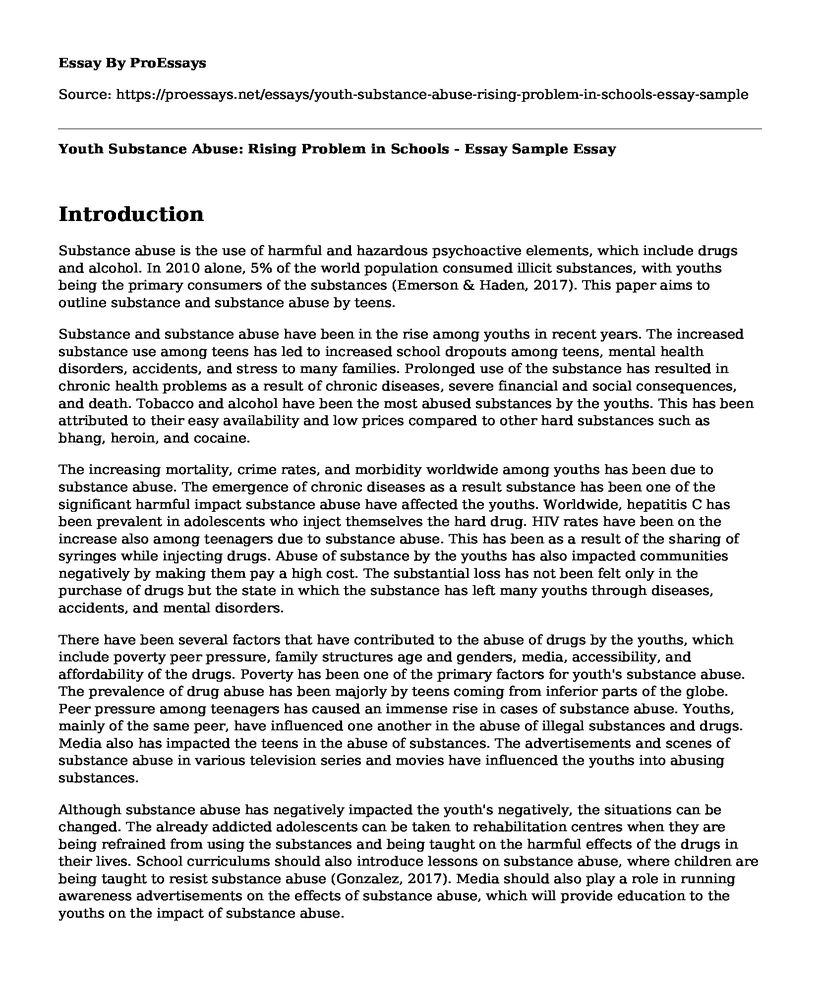Introduction
Substance abuse is the use of harmful and hazardous psychoactive elements, which include drugs and alcohol. In 2010 alone, 5% of the world population consumed illicit substances, with youths being the primary consumers of the substances (Emerson & Haden, 2017). This paper aims to outline substance and substance abuse by teens.
Substance and substance abuse have been in the rise among youths in recent years. The increased substance use among teens has led to increased school dropouts among teens, mental health disorders, accidents, and stress to many families. Prolonged use of the substance has resulted in chronic health problems as a result of chronic diseases, severe financial and social consequences, and death. Tobacco and alcohol have been the most abused substances by the youths. This has been attributed to their easy availability and low prices compared to other hard substances such as bhang, heroin, and cocaine.
The increasing mortality, crime rates, and morbidity worldwide among youths has been due to substance abuse. The emergence of chronic diseases as a result substance has been one of the significant harmful impact substance abuse have affected the youths. Worldwide, hepatitis C has been prevalent in adolescents who inject themselves the hard drug. HIV rates have been on the increase also among teenagers due to substance abuse. This has been as a result of the sharing of syringes while injecting drugs. Abuse of substance by the youths has also impacted communities negatively by making them pay a high cost. The substantial loss has not been felt only in the purchase of drugs but the state in which the substance has left many youths through diseases, accidents, and mental disorders.
There have been several factors that have contributed to the abuse of drugs by the youths, which include poverty peer pressure, family structures age and genders, media, accessibility, and affordability of the drugs. Poverty has been one of the primary factors for youth's substance abuse. The prevalence of drug abuse has been majorly by teens coming from inferior parts of the globe. Peer pressure among teenagers has caused an immense rise in cases of substance abuse. Youths, mainly of the same peer, have influenced one another in the abuse of illegal substances and drugs. Media also has impacted the teens in the abuse of substances. The advertisements and scenes of substance abuse in various television series and movies have influenced the youths into abusing substances.
Although substance abuse has negatively impacted the youth's negatively, the situations can be changed. The already addicted adolescents can be taken to rehabilitation centres when they are being refrained from using the substances and being taught on the harmful effects of the drugs in their lives. School curriculums should also introduce lessons on substance abuse, where children are being taught to resist substance abuse (Gonzalez, 2017). Media should also play a role in running awareness advertisements on the effects of substance abuse, which will provide education to the youths on the impact of substance abuse.
Conclusion
Substance abuse among youths has led to significant health problems around the globe. Factors that have resulted in substance abuse have been due to economic, social, and individual vulnerabilities. They have negatively impacted families and communities. Allocation of resources and involvement of stakeholders should be used in the fight against substance abuse by the youths.
Annotated Bibliography
Emerson, B., & Haden, M. (2017). Public Health and the Harm Reduction Approach to Illegal Psychoactive Substances. Quah, WC and Cockerham (eds.), International Encyclopedia of Public Health.
Emerson & Haden (2017) in their article points out the illegal psychoactive substances being abused and the current models used in the management of drugs.
Gonzalez, M. B. (2017). Exploring Community and Cultural Opportunities to Decrease Substance Abuse among American Indian Youth: A Photovoice Project (Doctoral dissertation, University of Minnesota).
Gonzalez, (2017) in his article articulates the development sustainable programs which are culturally good to decrease the amount of substance and promotion of health.
References
Emerson, B., & Haden, M. (2017). Public Health and the Harm Reduction Approach to Illegal Psychoactive Substances. Quah, WC, and Cockerham (eds.), International Encyclopedia of Public Health.
Gonzalez, M. B. (2017). Exploring Community and Cultural Opportunities to Decrease Substance Abuse among American Indian Youth: A Photovoice Project (Doctoral dissertation, University of Minnesota).
Cite this page
Youth Substance Abuse: Rising Problem in Schools - Essay Sample. (2023, May 23). Retrieved from https://proessays.net/essays/youth-substance-abuse-rising-problem-in-schools-essay-sample
If you are the original author of this essay and no longer wish to have it published on the ProEssays website, please click below to request its removal:
- Paper Example on Contributions of Females During and After the First and the Second World Wars
- Animals Rights and Wrong by Rodger Scruton Essay Example
- Gender Differences Annotated Bibliography
- Essay Sample on Feminist Theory: Examining Women's Oppression & Creating New Knowledge
- Addressing Childhood Obesity in Alabama: Healthcare Professional-Led Intervention - Research Paper
- The Lowering of Confederate Symbols: Rejecting Hate & Discrimination - Essay Sample
- Women in Workplaces: Tackling Inequality Through Transparency and Accountability - Essay Sample







